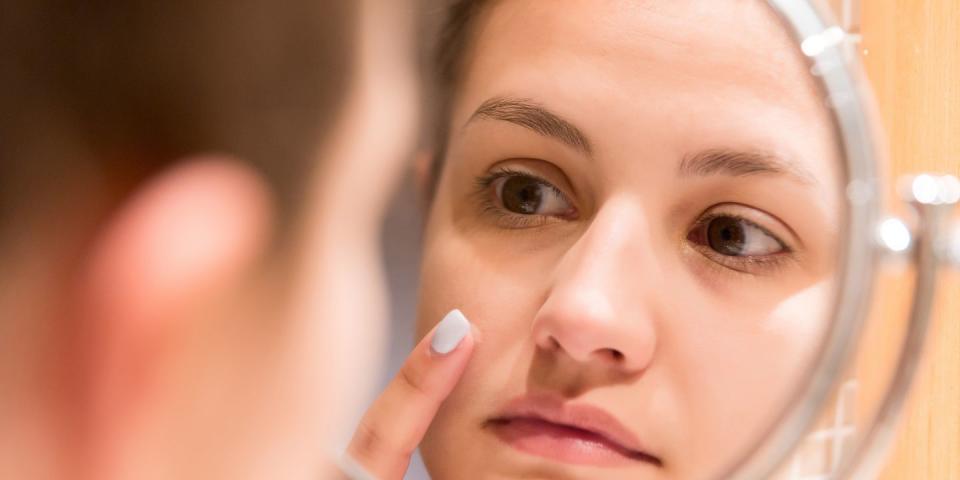
You look in the mirror and there they are: a bunch of tiny, hard white spots on your face, possibly with a faint blue tint. They don’t look or feel like a typical zit or whitehead, so what could they be? Most likely, they're something called milia, or tiny pockets of dead skin.
“Milia are made of keratin,” says Farah Moustafa, MD, dermatologist and director of laser and cosmetics at Tufts Medical Center in Boston. They commonly develop on the cheeks, eyelids and the nose. As your skin naturally exfoliates old cells so that new ones can develop, the cells can get trapped, harden and become cystic — that’s milia. “Think of them as pimples with nowhere to go,” says Joshua Zeichner, MD, a dermatologist and the director of Cosmetic and Clinical Research in Dermatology at Mount Sinai Hospital in New York City.
These benign cysts — sometimes called “milk spots”— are very common in infants; about 50% of babies have them at birth, according to the Cleveland Clinic. But they can show up on anyone at any age.
What causes milia in adults?
According to Dermatology Advisor, there are different types of milia, including neonatal milia, the type that shows up on infants' skin. The most common type in adults is primary milia; there are two other types that are less common, one that occurs in clusters on your skin and another that's caused by trauma to the skin.
Besides the process of skin cells being trapped during the natural process of exfoliation, milia can also occur because of other factors. “They may be due to sun damage or from heavy skin care products,” Dr. Zeichner says. Oil-based makeup or cleansers can be a culprit, if they clog your pores.
Skin damage from an injury or a rash, or prolonged use of corticosteroids, can also be a possible cause. Additionally, certain medical conditions can cause milia to form. “Milia can be a secondary symptom of a blistering skin condition, like a burn,” explains Dr. Moustafa. “They can also happen because of an autoimmune disease or genetic condition.” You can also get milia if you don’t cleanse your skin regularly, and you may be more prone to develop them if you have rosacea or dandruff.
The first thing you may wonder is whether you should see a doctor if you have milia. Most often, there's no need to. “Milia are completely harmless and are strictly a cosmetic issue,” says Dr. Zeichner.
Often times, they'll simply go away on their own. But if yours are sticking around, and they bug you, don’t try any of the “milia removers” you see online – they’re completely ineffective, experts say.
How to get rid of and prevent milia:
Don't try to remove them yourself.
It's never a good idea to try a pop milia like a pimple (you also shouldn't be popping your pimples either!). "Never poke or prod milia,” advises Dr. Moustafa. “And avoid scrubbing milia with any kind of gritty exfoliant.”
Focus on gentle cleansing.
Here's the best daily remedy to try: “Gentle skin care,” says Dr. Moustafa. Wash your face the right way, following advice from the American Academy of Dermatology: Using a gentle cleanser and your fingertips, wash with lukewarm water, avoiding scrubbing and rinse with lukewarm water and pat dry with a soft towel. Also, make sure your skin has a chance to breathe and be free of makeup every once in a while.
Try topical retinoid cream.
If you have a predisposition to milia, your dermatologist may recommend you try a topical retinoid if you have a recurrence. “This can help by removing cells in the outer skin layer, encouraging eventual release of the milia from your skin,” says Dr. Zeichner.
Always wear sunscreen.
This is a golden rule even if you don't have milia, but sun burn and damage can be common contributors. Be sure to properly apply at least an SPF 30 sunscreen to your skin 30 minutes before heading outside. Birnur K. Aral, Ph.D., the Good Housekeeping Institute's Beauty, Health & Sustainability Lab executive director, suggests applying a nickel-size dollop to your face. For sprays, she suggests spraying the sunscreen all over skin, then rubbing it in.
Visit dermatologist for professional removal.
To actually remove milia, you need to have them extracted from your skin. “This means when a dermatologist physically creates an opening with a needle or a scalpel blade,” says Dr. Zeichner. “Never do this yourself. Trying to remove milia the wrong way can lead to infections or scars.” And he adds, “Milia around the eyes are particularly difficult to address, because of their proximity to your eyeball.”
The actual process of removing milia is called de-roofing. A dermatologist uses a needle to remove the flap that’s trapping the keratin in your skin and pluck out the keratin itself. The procedure isn’t covered by insurance, though, and can be a bit pricey, ranging from $200-$500 on average.
You Might Also Like
The Link LonkDecember 31, 2022 at 04:15AM
https://news.google.com/__i/rss/rd/articles/CBMiR2h0dHBzOi8vd3d3LnlhaG9vLmNvbS9saWZlc3R5bGUvd2h5LW5ldmVyLXBvcC10aG9zZS10aW55LTIxMTUwMDE4OC5odG1s0gFPaHR0cHM6Ly93d3cueWFob28uY29tL2FtcGh0bWwvbGlmZXN0eWxlL3doeS1uZXZlci1wb3AtdGhvc2UtdGlueS0yMTE1MDAxODguaHRtbA?oc=5
Why You Should Never Pop Those Tiny, Hard Bumps on Your Face - Yahoo Life
https://news.google.com/search?q=hard&hl=en-US&gl=US&ceid=US:en
No comments:
Post a Comment